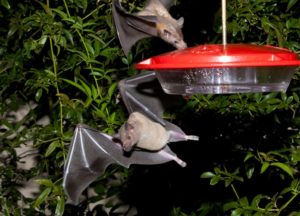The lesser long-nosed bat is no longer in danger of extinction, according to the U.S. Fish and Wildlife Service (USFWS), so it will be taken off the endangered species list. New Mexico and Arizona leaders have advocated de-listing for years. They are getting their wish, partly because of red plastic hummingbird feeders.
 The bats’ attraction to hummingbird feeders is nothing new. Local hummingbird watchers considered bats pests for many years because of it. But after these particular bats were listed as endangered in 1988, and thus protected by the toughest of laws, people started paying closer attention.
The bats’ attraction to hummingbird feeders is nothing new. Local hummingbird watchers considered bats pests for many years because of it. But after these particular bats were listed as endangered in 1988, and thus protected by the toughest of laws, people started paying closer attention.
Initially, the species was referred to as “Sanborn’s long-nosed bat,” though the government dropped that moniker about 20 years ago. At that time, the Fish and Wildlife Service estimated that there were only 1,000 of the bats left, all of them in one last remaining roost, in a cave in Big Bend National Park, Texas. Because this particular bat feeds on the nectar of agave plants – the same plants used to make mescal and tequila – it was assumed that the primary threats to the bat were agave harvesting and cattle grazing, both of which activists wanted to stop.
A decade after the endangered listing, the government got around to publishing a “recovery plan,” which consisted mostly of closing bat caves to the public, identifying any other places that could be potential habitat, and of course, working to stop such threats as urban development, livestock grazing, and agave harvesting. Lots of money was also spent “improving communication” among agencies, compiling studies, and determining where such studies ought to be housed (that took several years, really). Important details had to be studied, such as mating habits, and whether flying bats “swirling” on their way into caves might result in double-counting.
One of the things government biologists wanted to study was whether bats eating the nectar of agave plants actually helped pollinate those plants. That’s where the hummingbird feeders came in. You see, local hummingbird fans had known for many years that bats like to eat the nectar, but it was difficult to catch them in the act, because bats are nocturnal. However, because endangered species enforcement threatened important economic activities (especially ranching, but also tequila production), several citizen groups were organized to monitor hummingbird feeders at night. In turn, that created an opportunity to capture and tag bats, so that researchers could find out where they were roosting. That led to the discovery of many more roosting sites, and a conclusion that there were far more bats than originally thought.
Stories like this have played out so many times in the world of endangered species that they almost write themselves. Within a few years, it was found that there were not just 1,000 lesser long-nosed bats remaining in a single cave, but more like 200,000 in dozens of roosts across the entire region.
As a result of all this new information, the government did nothing, and conducted only one of the legally-required “5-Year Reviews” in 2005. By 2012, frustrated New Mexico and Texas agriculture groups filed a new petition seeking to “downlist” the species, lessening its protected status from “endangered” to “threatened” (a lower level with slightly less onerous regulations). A year later, the USFWS agreed that “downlisting” may be warranted, but by mid-2016 nothing had been done, so New Mexico Cattle Growers filed suit. Finally, in order to settle the lawsuit, the USFWS agreed to issue a final decision by the end of 2016. A year and a half later, in the face of overwhelming evidence, the government has finally begun the process of removing the species from all threatened and endangered lists.
That is a remarkable achievement, since fewer than one percent of the over 2,000 species added to the list have ever been removed. The USFWS claims the bats have been “recovered” and can therefore be delisted. It is more likely they were never that rare in the first place, just poorly counted. A new landmark study by the Heritage Foundation’s Rob Gordon, one of the nation’s premier Endangered Species Act experts, demonstrates that a number of species now declared recovered (so the agency can claim credit) were in fact originally listed in error.
Either way, the bats may have remained on the endangered list forever, with dire consequences for beef and tequila lovers, but for the intervention of hummingbird watchers. It is unclear whether either the bats or hummingbirds were aware of all this activity on their behalf. Perhaps we need another study.
A version of this column originally appeared in the Grand Junction Daily Sentinel May 11, 2018.




Comments on this entry are closed.